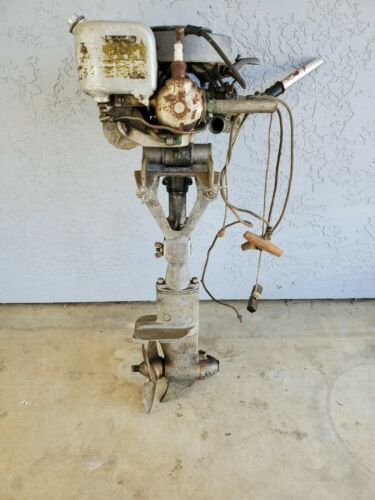-40%
Johnson Outboard Model A-35 2.5HP built in 1927 Rare
$ 34.84
- Description
- Size Guide
Description
Johnson Model A Outboard Motor Complete Waterbug Canoe Rare.Engine is free! Not froze...
Sold as is
Johnson outboard motors made their public debut at the New York Boat Show in January 1922. It is unlikely that the Johnson brothers; Lou, Harry, Clarence and their brother-in-law Warren Conover, had any idea of the impact their little outboard would have on the world of boating.
The Johnson brothers were cut from the same cloth as many of the great American engineers of the early part of the 20th century. From relatively humble beginnings in Terre Haute Indiana, the Johnson’s became some of the premiere engineers of their day. The manufacturing of their small two cylinder outboard would not look very grand on their resumes when compared to building the first American monoplane, aircraft engines and record setting inboard speedboat engines, yet outboards would be their most lasting achievement.
The small 2hp outboard that went on sale in 1922 had its roots in failure. After their aircraft and engine factory was destroyed in a storm, the brothers concentrated their efforts on a small two cylinder air-cooled motor that they adapted to be used as a helper engine on a bicycle. These Johnson Motor Wheels sold well for several years, but the economies of scale with which Henry Ford and others could produce automobiles rapidly eroded the market - after all, who would buy a motorized bicycle for the same cost as an automobile?
Typical of the determination Americans had at the time, Lou Johnson was able to adapt some of the Motor Wheel’s engine to a new purpose; an outboard motor. The water cooled 2 cylinder outboard would weigh in at only 35lbs, this was about ½ that of the typical cranky rowboat motors of the day. Six pre-production motors are believed to have been produced, full-fledged production began with serial number 507. There can be no doubt that the Johnson’s hit a home run when sales for their little 0 outboard topped 3324 units their first year.
Why was the Johnson's little outboard such a tremendous success? In addition to being lighter in weight, the Johnson Waterbug or Light Twin (Both names were used in the advertising) incorporated many features that we take for granted today but were revolutionary in 1922. A key component was the reliable flywheel magneto from the Quick Action Magneto Co of South Bend IN - later to become part of the Johnson company. Many outboards in 1922 used battery ignition and some still had large gear driven magnetos like the ones used on cars & tractors. The Johnsons Quick Action Magneto was small, compact and among the most reliable ever constructed. This magneto proved so good that the majority are still working 85 years later!
Another feature was the use of a rope to start the motor. Here again, Johnson set the trend over the competition who used “knucklebuster” knobs, leather straps or required the operator to wrestle the flywheel to start their outboards. (These were the days long before OSHA!) The rope start was simple, relatively safe (as long as you don’t whip someone with the cord!) and effective.
There were a number of other novel features incorporated in the Johnson outboard; the easy to use and reliable carburetor with three settings; Choke, Fast & Slow. A simple piston waterpump to cool the motor was employed for many years. And to keep the motor on the boat but still make it detachable in a jiffy, secure screw-type transom clamps were used. (Some outboards required you to bolt them on the transom!) The ability to tilt the motor up when beaching or in shallow water was also a rare on other outboards in 1922. While these features may be commonplace today, the Johnson brothers were the first to combine all of them.
One of the most welcome and useful new features on the Waterbugs was the ability to turn (or swivel) the motor through a full 360 degrees. This gave the operator much greater maneuverability and a positive acting reverse for bringing the boat into the dock. While this feature had been used for some time by the European brand Penta, (the Johnson’s licensed it from them), Johnson was the first US company to popularize it. This feature met with immediate public acceptance and is still incorporated on many small outboards today.
The success of the Johnson outboard and its variants; salt water (brass & bronze), canoe mount and even the very rare Model F inboard, was immediate and far reaching. Almost overnight the Johnson’s were producing more outboard motors than anyone else in the world and they worked hard to keep the lead.
The Model A received an update in 1925 becoming the A-25 and also received a single cylinder brother the J-25 the same year. In 1926 a larger motor called the Model P and rated at 6 horsepower, was introduced. Each subsequent year more models and higher horsepower models were produced, outboarding having caught the publics fancy in a big way! Competition from rivals like Ole Evinrude’s second company Elto, Lockwood and the original Evinrude firm, created a swarm of advancements in technology & horsepower. Johnson lead the way with many new features in the late 1920’s; rotary valving, higher horsepower and, possibly their crowning achievement, the smooth alternate firing A and K models of 1930. (1929 was the first time the famous Sea Horse logo appeared!)
Condition is "Used".



















